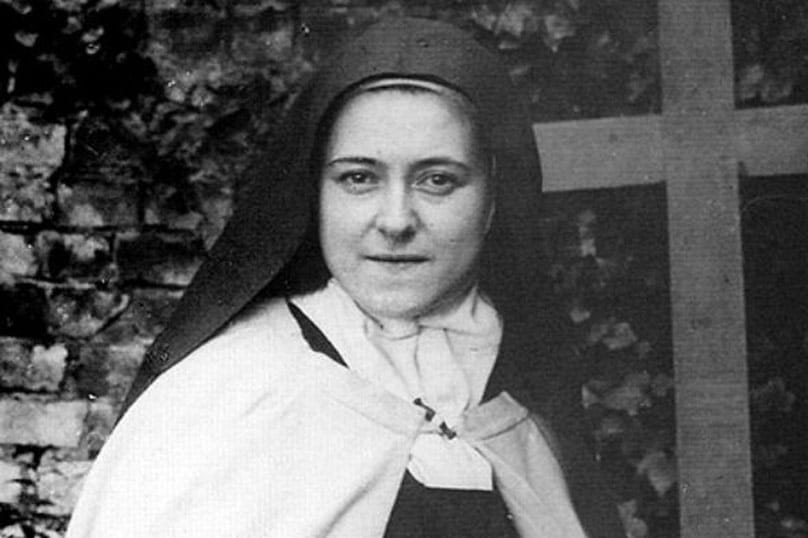
Beloved saint radiated God’s strength in her weakness
St Therese of Lisieux is depicted in statues in many a Catholic church; a young woman with soft brown eyes and high cheekbones, dressed with a light coloured cloak over floor-length dark brown habit. She’s generally recognised by the pink or yellow roses and a crucifix held with slender hands to her breast. In one sense, she makes a perfect plaster saint.
Indeed, maybe a little bit too perfect. The cult of her personality may make it seem hard for us in our time and culture to identify with her, or see in her a real friend who understands our life with its ordinariness, contradictions, doubt and pain.
Her writing style can put some people off as well. More than a century after her death she is one of the most-loved Saints but I know that some people find her writings syrupy and sentimental when they attempt to ‘get into’ them. That’s ok, God has given us plenty of saints and we call all have our besties. I just figure that they’ll get a nice surprise in heaven when they come across this funny and endlessly creative woman who admitted towards the end of her life she was experiencing doubt, depression and at least once, crushed by excruciating pain and sleeplessness, temptation to suicide.
A friend mentioned once that if you want to understand of St John of the Cross’ teachings on the spiritual life, and how they work in practice, just look at St Therese.
She’s known as the little flower, because that’s the way she described herself and the way God loves her at the start of her autobiography, Story of a Soul. She also said, when she was close to dying of tuberculosis and with a painful bowel obstruction at 24, that she would spend her heaven showering rose petals on earth, meaning graces from God. And so to the devotionally minded the sight of a rose is often taken as a sign of a prayer, usually for some kind of healing, that has been answered through her intercession.
I like the image of St Therese as she expressed herself in the poem An Unpetalled Rose. For me it calls to mind her teaching of the Little Way of spiritual childhood. In part, this is that we can do any little thing with love, and win God’s heart. God will accept and use it to further increase our love and our efficacy in the world that he made and loves.
A little way to heaven – simple love and suffering
To Therese, that meant something as simple as a kind look or a smile when we don’t feel like giving it. She describes overcoming her intense irritation when a clumsy nun kept splashing her in the face with dirty washing up water, and using her precious recreation time to befriend the one nun that everyone else understandably avoided.
Her life also held plenty of worse suffering, and apart from one special grace when she was a teenager, she never had any visions or great signs that God noticed or cared about her efforts to love. In her Gospel wisdom, she lived like a small child to whom it never occurs to ask for proof of its parents’ love, it simply lives in that truth. She knew this insight into the gospel was a gift she was meant to share with the rest of us. She shows us a path of pure faith, trust and love.
For me, I don’t know what I appreciate about her the most. Her teaching of the Little Way of course, and the way she explained how God loves each and every person completely, but perhaps also her insight into the equal and full justice and mercy of God, and her evident understanding and kindness towards people (like me!) who do not have the tranquil trust that she was given to express.
Here are a couple of the stanzas (translated into English) from An Unpetalled Rose. It shows her determination to be extraordinarily generous with her short life. She uses the romantic image of scattered rose petals, and turns it on its head – she sees herself as the discarded stub of a ripped up flower. Rather than pity herself she sees that is the reality in which she is being asked to love Christ.
The rose in its splendor can adorn your feast,
Lovable Child,
But the unpetalled rose is just flung out
To blow away.
An unpetalled rose gives itself unaffectedly
To be no more.
Like it, with joy I abandon myself to you,
Little Jesus.
One walks on rose petals with no regrets,
And this debris
Is a simple ornament that one disposes of artlessly,
That I’ve understood.
Jesus, for your love I’ve squandered my life,
My future.
In the eyes of men, a rose forever withered,
I must die!
That may come across as a little bit morbid, but Therese wasn’t really interested in anything more than life, life to the full as Jesus promised it would be if we only let him love us. And she did respond to his love with everything she had, most generously, expressly as a Carmelite for the sake the world’s clergy, and for all of us. Her life exploded and its graces multiplied after her death on 30 September 1897, as many, many stories told of her after that day, even up to today, will attest!
St Therese of Lisiuex’s feast day is 1 October.
Related:
Visions in the trenches: St Therese appears to soldiers of the Western Front
